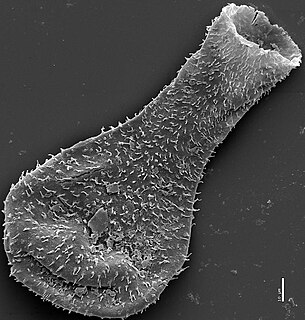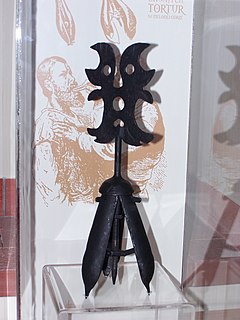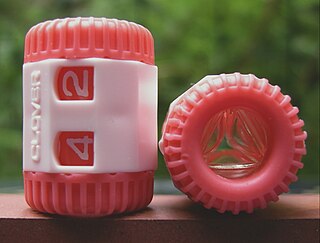
A printing press is a mechanical device for applying pressure to an inked surface resting upon a print medium, thereby transferring the ink. It marked a dramatic improvement on earlier printing methods in which the cloth, paper or other medium was brushed or rubbed repeatedly to achieve the transfer of ink, and accelerated the process. Typically used for texts, the invention and global spread of the printing press was one of the most influential events in the second millennium.

Renaissance music is traditionally understood to cover European music of the 15th and 16th centuries, later than the Renaissance era as it is understood in other disciplines. Rather than starting from the early 14th-century ars nova, the Trecento music was treated by musicology as a coda to Medieval music and the new era dated from the rise of triadic harmony and the spread of the ' contenance angloise ' style from Britain to the Burgundian School. A convenient watershed for its end is the adoption of basso continuo at the beginning of the Baroque period.

A galvanometer is an electromechanical measuring instrument for electric current. Early galvanometers were uncalibrated, but improved versions, called ammeters, were calibrated and could measure the flow of current more precisely.

Romanesque architecture is an architectural style of medieval Europe characterized by semi-circular arches. There is no consensus for the beginning date of the Romanesque style, with proposals ranging from the 6th to the 11th century, this later date being the most commonly held. In the 12th century it developed into the Gothic style, marked by pointed arches. Examples of Romanesque architecture can be found across the continent, making it the first pan-European architectural style since Imperial Roman architecture. The Romanesque style in England and Sicily is traditionally referred to as Norman architecture.

A carriage is a private four-wheeled vehicle for people and is most commonly horse-drawn. Second-hand private carriages were common public transport, the equivalent of modern cars used as taxis. Carriage suspensions are by leather strapping and, on those made in recent centuries, steel springs. Two-wheeled carriages are informal and usually owner-driven.

The Nervii were one of the most powerful Belgic tribes of northern Gaul at the time of its conquest by Rome. Their territory corresponds to the central part of modern Belgium, including Brussels, and stretched southwards into French Hainault. During their first century BC Roman military campaign, Julius Caesar's contacts among the Remi stated that the Nervii were the most warlike of the Belgae. In times of war, they were known to trek long distances to take part in battles. Being one of the distant northern Belgic tribes, with the Menapii to the west, and the Eburones to their east, they were considered by Caesar to be relatively uncorrupted by civilization.

A crank is an arm attached at a right angle to a rotating shaft by which circular motion is imparted to or received from the shaft. When combined with a connecting rod, it can be used to convert circular motion into reciprocating motion, or vice versa. The arm may be a bent portion of the shaft, or a separate arm or disk attached to it. Attached to the end of the crank by a pivot is a rod, usually called a connecting rod (conrod).

A clock face is the part of an analog clock that displays time through the use of a flat dial with reference marks, and revolving pointers turning on concentric shafts at the center, called hands. In its most basic, globally recognized form, the periphery of the dial is numbered 1 through 12 indicating the hours in a 12-hour cycle, and a short hour hand makes two revolutions in a day. A long minute hand makes one revolution every hour. The face may also include a second hand, which makes one revolution per minute. The term is less commonly used for the time display on digital clocks and watches.
The English language terminology used in the classification of swords is imprecise and has varied widely over time. There is no historical dictionary for the universal names, classification or terminology of swords; a sword was simply a double edged knife.

The Ancient Romans developed the Roman hand abacus, a portable, but less capable, base-10 version of earlier abacuses like those that were used by the Greeks and Babylonians.

Chitinozoa are a group of flask-shaped, organic walled marine microfossils produced by an as yet unknown organism. Common from the Ordovician to Devonian periods, the millimetre-scale organisms are abundant in almost all types of marine sediment across the globe. This wide distribution, and their rapid pace of evolution, makes them valuable biostratigraphic markers.

The French nobility was a privileged social class in France from the Middle Ages until its abolition on June 23, 1790 during the French Revolution.

The Church of Saint-Germain-des-Prés is a Roman Catholic parish church located in the Saint-Germain-des-Prés quarter of Paris. It was originally the church of a Benedictine abbey founded in the 6th century, by Childebert I, the son of Clovis, King of the Franks. It was destroyed by the Vikings, rebuilt, and renamed in the 8th century for Saint Germain, an early Bishop of the city. It is considered the oldest existing church in Paris.

A stamp mill is a type of mill machine that crushes material by pounding rather than grinding, either for further processing or for extraction of metallic ores. Breaking material down is a type of unit operation.

A bookmark is a thin marking tool, commonly made of card, leather, or fabric, used to keep track of a reader's progress in a book and allow the reader to easily return to where the previous reading session ended. Alternate materials for bookmarks are paper, metals like silver and brass, silk, wood, cord (sewing), and plastic. Some books may have one or more bookmarks made of woven ribbon sewn into the binding. Furthermore, other bookmarks incorporate a page-flap that enables them to be clipped on a page.

French Renaissance architecture is a style which was prominent between the late 15th and early 17th centuries in the Kingdom of France. It succeeded French Gothic architecture. The style was originally imported from Italy after the Hundred Years' War by the French kings Charles VII, Louis XI, Charles VIII, Louis XII and François I. Several notable royal châteaux in this style were built in the Loire Valley, notably the Château de Montsoreau, the Château de Langeais, the Château d'Amboise, the Château de Blois, the Château de Gaillon and the Château de Chambord, as well as, closer to Paris, the Château de Fontainebleau.

French Gothic architecture is an architectural style which emerged in France in 1140, and was dominant until the mid-16th century. The most notable examples are the great Gothic cathedrals of France, including Notre-Dame Cathedral, Reims Cathedral, Chartres Cathedral, and Amiens Cathedral. Its main characteristics were the search for verticality, or height, and the innovative use of the rib vault and flying buttresses and other architectural innovations to distribute the weight of the stone structures to supports on the outside, allowing unprecedented height and volume. The new techniques also permitted the addition of larger windows, including enormous stained glass windows, which filled the cathedrals with light. The French style was widely copied in other parts of northern Europe, particularly Germany and England. It was gradually supplanted as the dominant French style in the mid-16th century by French Renaissance architecture.

The pear of anguish, also known as choke pear or mouth pear, is a torture device based on mechanisms of unknown use from the early modern period. The mechanism consists of a pear-shaped metal body divided into spoon-like segments that can be spread apart with a spring or by turning a key. Its proposed functionality as a torture device is to be variously inserted into the mouth, rectum, or vagina, and then expanded to gag or mutilate the victim.

A row counter for hand knitting is a tally counter for counting rows or courses worked, for counting stitch pattern repetitions, or for counting increases or decreases of the number of stitches in consecutive rows. The first commercially produced one appeared on the market in the 1920s after the general public started regularly knitting from unfamiliar printed and complex patterns. Design variations include on-needle barrel-shaped counters for straight-needle work, stitch-marker counters for knitting on double-pointed and circular needles, complex counters which attempted to assist with decreases, increases and lacework, stand-alone hand-held counters in imitation of the hand-tally, pendant counters worn round the neck and online software for iPhones.
The history of animation started long before the development of cinematography. Humans have probably attempted to depict motion as far back as the paleolithic period. Much later, shadow play and the magic lantern offered popular shows with projected images on a screen, moving as the result of manipulation by hand and/or minor mechanics. In 1833, the stroboscopic disc introduced the stroboscopic principles of modern animation, which decades later would also provide the basis for cinematography. This article covers the period up to 1888, when celluloid film base was developed, a technology that would become the foundation for over a century of film.


















